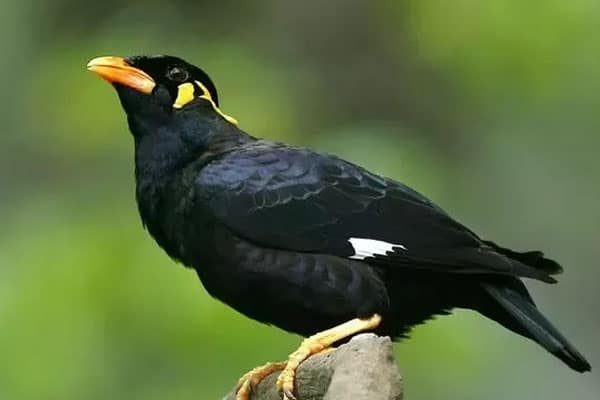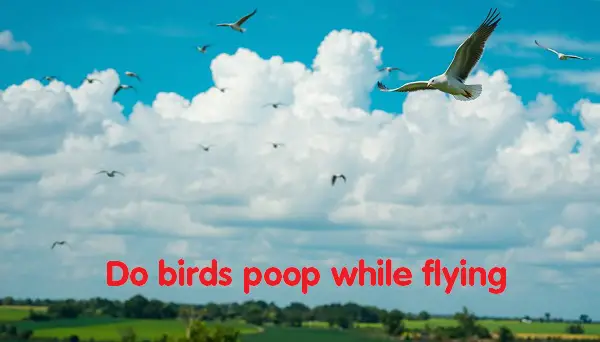Stunning Common Black Bird With Yellow Beak (With Photos)
Have you ever seen Black bird with yellow beak? The blackbird is one of the earliest signs of spring, often heard singing its melodious flute-like song as early as January. It likes to sing from high spots such as rooftops or treetops, allowing its song to carry over long distances.
As the blackbird finishes its song, it becomes quieter and more subdued, almost like a distant echo. In the past, blackbirds lived in dense forests with lots of bushes and plants.
But in the last hundred years, they’ve moved in large numbers to cities and urban areas. Now, they’re one of the most common birds to nest in Europe, adapting well to city life.
Here, You’ll Learn Everyhing About This Common Blackbird!
The blackbird is a daytime bird that migrates during autumn or winter, covering distances ranging from 800 to 2000 km. Interestingly, female blackbirds tend to migrate more than males when autumn arrives.
During migration, blackbirds typically fly close to the ground, often in short bursts with slow wing beats. For longer journeys, their flight is direct and slightly wavy. They’re skilled at flying long distances and often travel in groups at night.

These birds enjoy sunbathing, lying flat on the grass or warm ground with their beaks open and heads tilted, while spreading their wings and tail.
Due to habitat loss from heavy deforestation, blackbirds have moved closer to human homes. Now, they live near our houses, where they’ve learned to feed on leftover bread or fruit.
Blackbirds are territorial creatures, fiercely defending their space, especially in cities where each couple has limited room. Females will also fight to secure a good nesting spot.
Common Blackbird (Turdus merula):
- Scientific name: Turdus merula
- Weight: 80 – 110 g
- Wingspan: 34 – 39 cm
- Age: Up to 16 years in captivity, rarely beyond 3 years in the wild
- Diet: Worms, bugs, and fruits
- Habitat: Woods, agricultural areas, and urban areas
🎵 The Blackbird: A Springtime Singer 🎵
- The blackbird is a bird that sings beautifully, like a flute.
- It starts singing as early as January, announcing the arrival of spring.
- You can often hear its song from rooftops or treetops.
- The final part of its song is soft and echoes in the distance.
- Long ago, blackbirds lived in dense forests with lots of plants.
- But in the last hundred years, they’ve moved to cities and urban areas.
- Now, blackbirds are common nesters all across Europe.
1. Aspect
Male blackbirds can reach lengths of up to 25 centimeters and are typically covered in all-black or dark brown feathers. They have a beak that ranges from yellow to orange, and the skin around their eyes matches this color. However, their legs are usually dark brown.
In contrast, female blackbirds are a bit smaller, measuring between 15 to 20 centimeters in length. They have mostly dark brown feathers with a lighter, streaky throat.
2. Distribution
Blackbirds are found all over Europe, western Asia, and northwestern Africa. They’ve also been brought to places like Australia and New Zealand.
You can see them in the Canary Islands and Azores too. Blackbirds move around; they go to warmer places in the Mediterranean when it’s winter. But the ones that live where the weather doesn’t change much stay put all year.
Sometimes, only some blackbirds in a group will move to warmer places, while others stay home.
Black bird with yellow beak like living in woods, but they’re used to people now. So, you’re more likely to see them in places where people live, like parks, gardens, streets, and places where food grows, than out in the wild.
3. Diet
Blackbirds like to eat on the ground. They love fruits that give them lots of energy, like the common hawthorn. They pick fruits that don’t have many seeds and are easy to eat. Some of their favorites are sloe, ivy, elderberry, bramble, and dog rose.
What Blackbirds Eat: Besides fruits, blackbirds eat lots of bugs like cockroaches, caterpillars, and grasshoppers. They also munch on snails, spiders, and worms. To find these critters, they flip over leaves or poke around in moss. Blackbirds don’t go far when they move; they hop a little, stop suddenly, and look around for food. They use their beaks to dig in the dirt to find worms.
4. Breeding
The female blackbird makes the nest. You can find it on tree branches, in bushes, or even on the ground.
She lays 4 to 6 blue-grey eggs with grey spots, three times a year. The eggs take about two weeks to hatch, and the mom does most of the work.
About Blackbird Nests: The nests are made at different heights. For each new set of eggs, called a brood, the nest is built higher. The blackbirds don’t reuse nests; they make a new one every time. Usually, blackbirds live just with their mate, but sometimes they join other blackbirds in groups when they move to different places.
5. Conservation
Right now, blackbirds in Europe are doing pretty well. There are a lot of them—more than 40 million pairs—and their numbers stayed the same from 1970 to 1990.
From 1990 to 2000, there were even more blackbirds, especially in countries like Germany, France, and Italy. Most places in Europe have a stable or growing number of blackbirds, and scientists know a lot about where they live, what they do, and what they eat. But it’s important to say that some areas where blackbirds live don’t have exact numbers on how many there are.
Check Our Previous Articles
| What Time Do Birds Wake Up? |
| White Birds In Michigan |
| Falcons in North Carolina |
| Mousebirds (Family Coliidae) |
Frequently Asked Questions About Black Bird With Yellow Beak
Q1: Why do crows have yellow beaks?
Crows have yellow beaks due to the presence of a pigment called carotenoid, which gives their beaks their distinctive coloration.
Q2: What is the black bird in Australia with yellow beaks?
The black bird in Australia with yellow beaks is likely the Australian Raven (Corvus coronoides), which has a black plumage and a yellowish bill.
Q3: Can you eat blackbirds?
While it’s technically possible to eat blackbirds, they are not commonly consumed as they are protected in many regions and considered unpalatable due to their diet and small size.
Q4: What does it mean when black birds are around your house?
The presence of black birds around your house could simply indicate their attraction to nearby food sources or suitable habitat. In folklore, black birds are sometimes associated with omens or symbolic meanings, but this varies depending on cultural beliefs.







